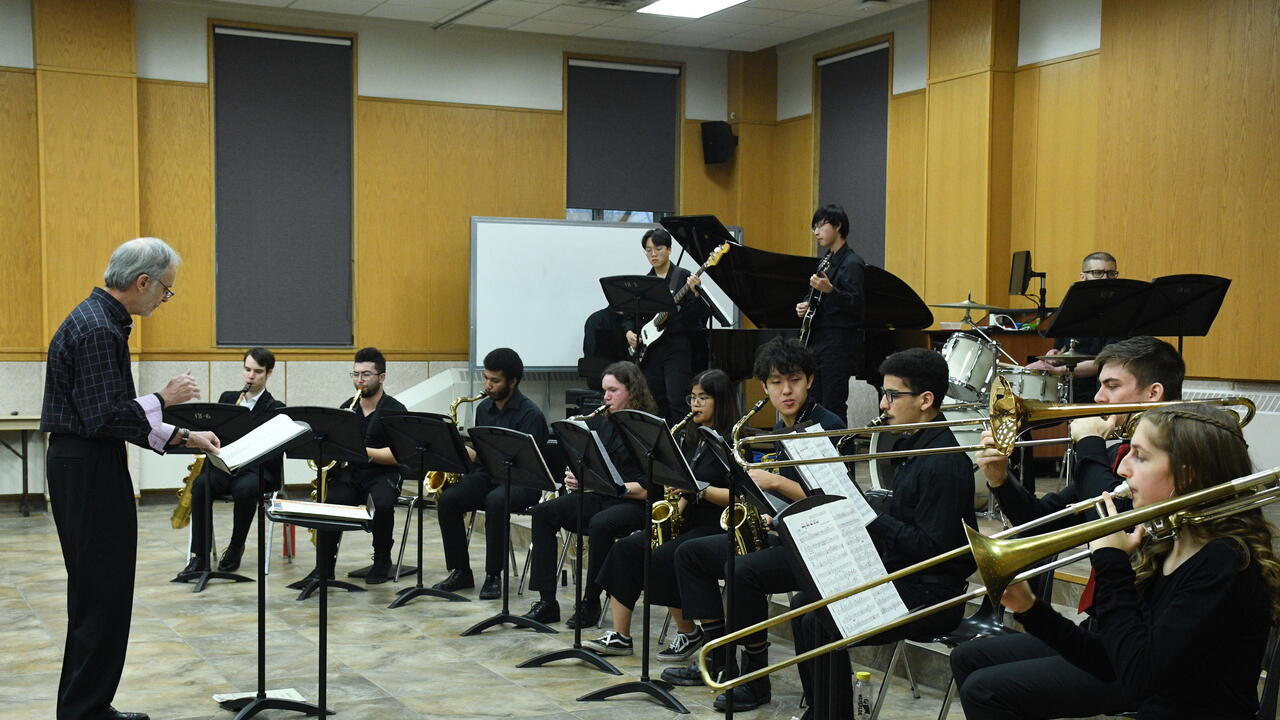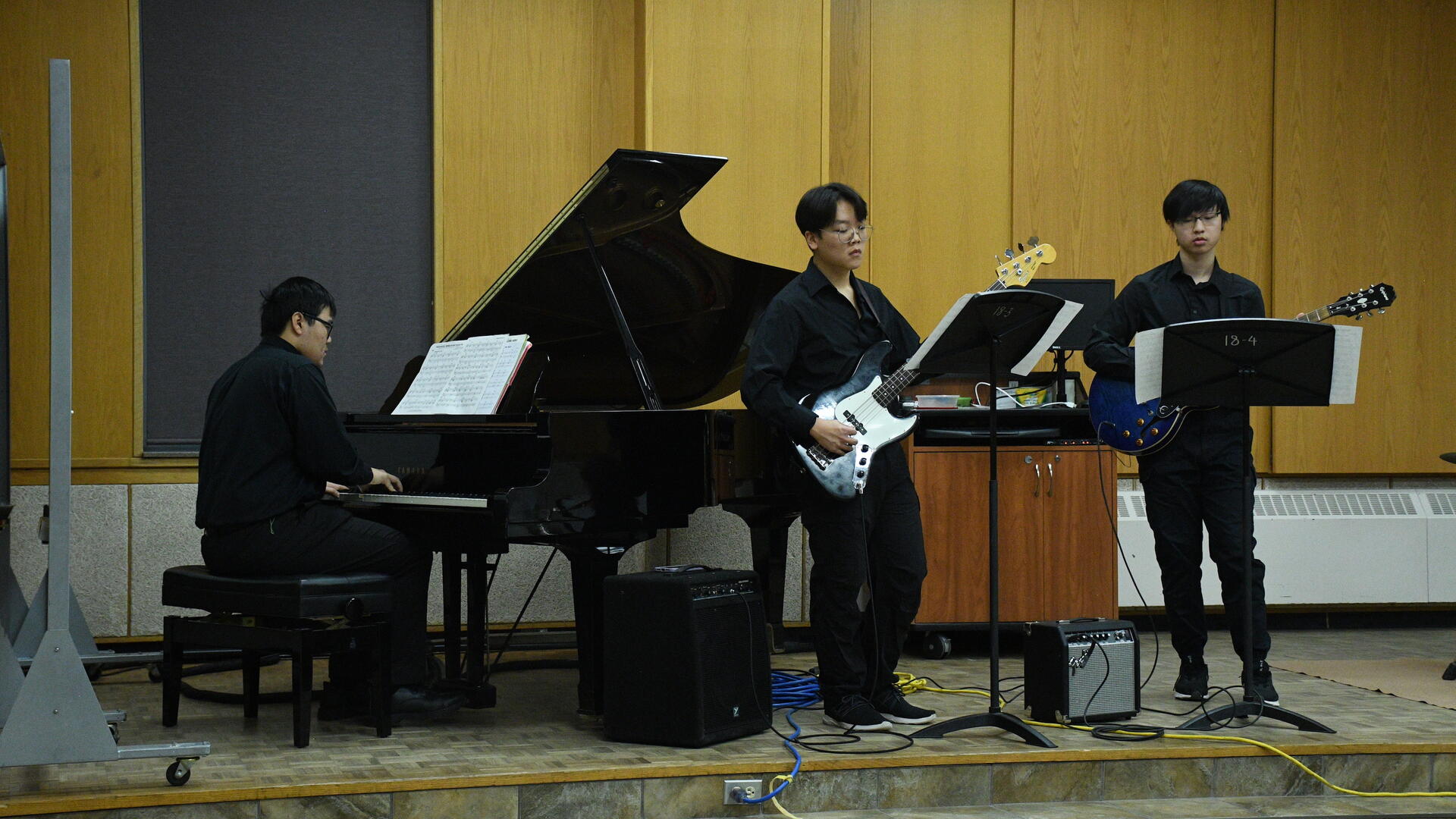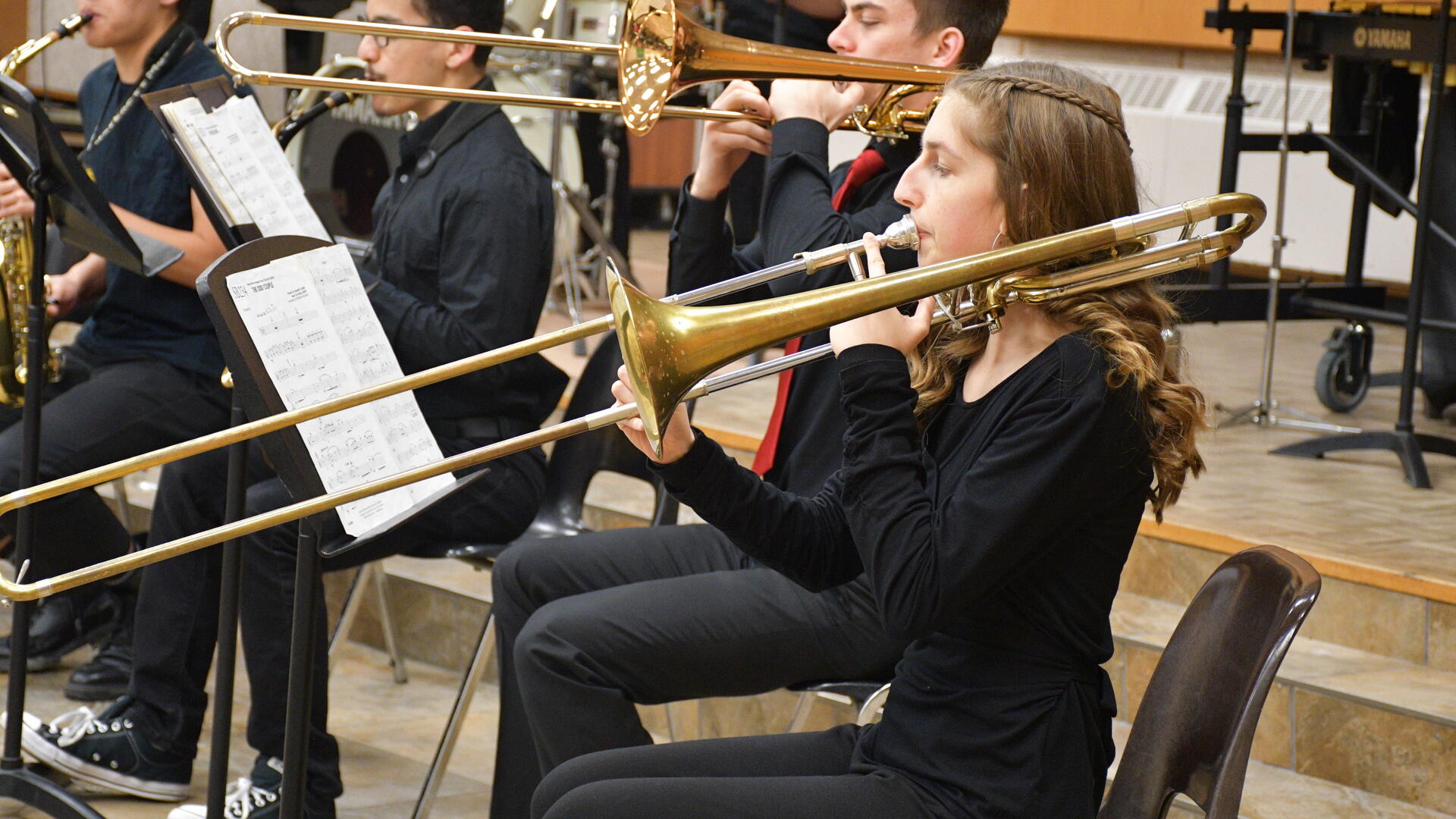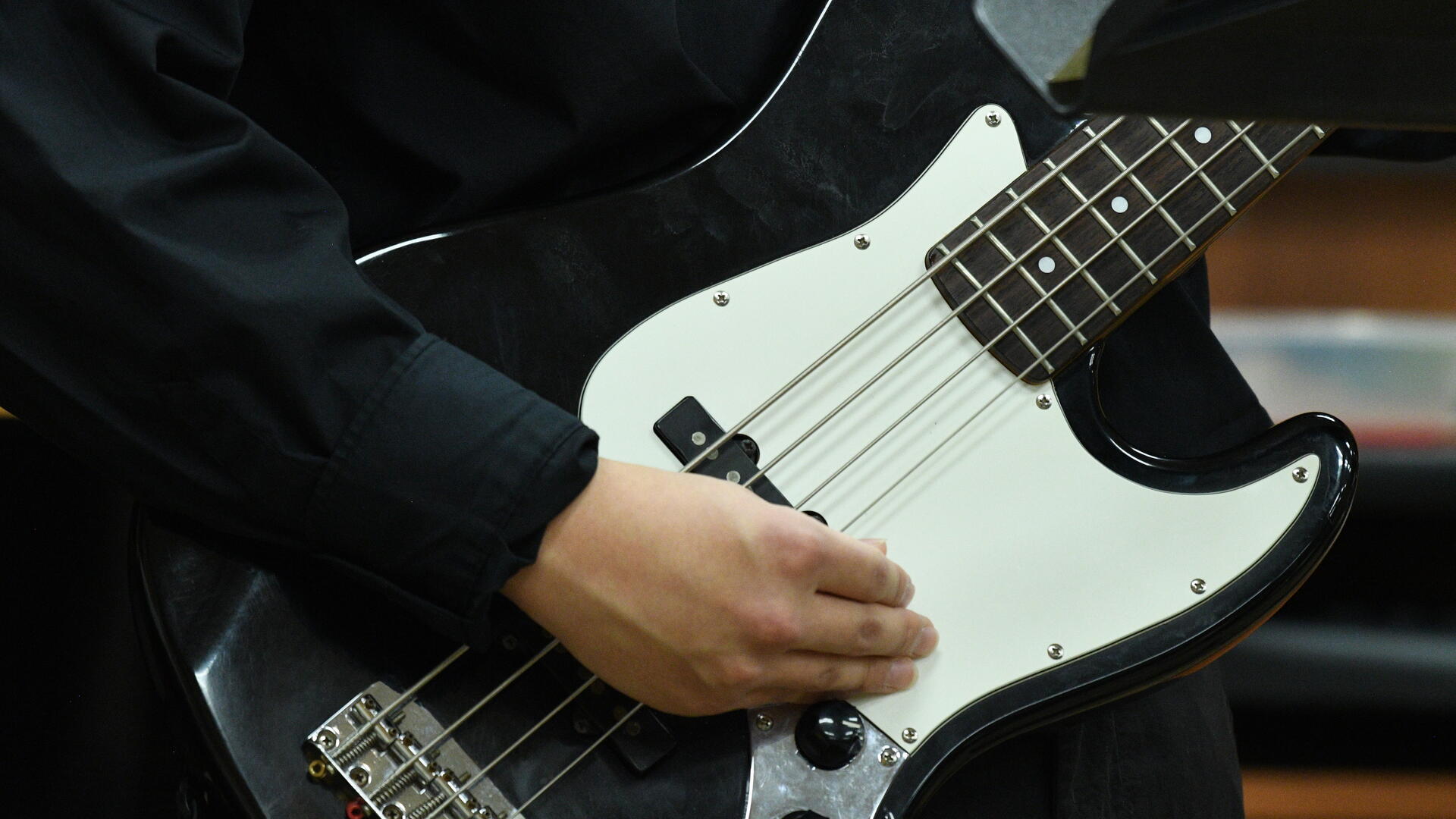
Math and all that jazz
Why are there so many Math students in the University of Waterloo Jazz Ensemble?

Why are there so many Math students in the University of Waterloo Jazz Ensemble?
By Melodie Roschman Faculty of MathematicsIn an interview with Down Beat magazine, the jazz legend Thelonious Monk once said that “All musicians are subconsciously mathematicians.”
For the University of Waterloo Jazz Ensemble, that connection between music and math is explicit. This fall term, there were 16 students and one alum in the Jazz Ensemble. Eight of those students were from the Faculty of Mathematics.
This high percentage of Math students makes perfect sense to David Hao, a computer science major who played piano in the ensemble this term. “Music, boiled down to its essentials, is the combination of sound waves – vibrations – that, when heard, elicit emotion,” he says. “It is a form of mathematical beauty.”
In a typical year, the jazz ensemble consists of 17 or 18 players: a large group of alto, tenor and baritone saxophones; a handful of trumpets and trombones; and then the rhythm section: piano, guitar, bass, drums and percussion.
For some students, like Kaitlyn Bowles, a math/business administration major and trumpet player, the Jazz Ensemble is the latest step in a jazz career that stretches back to elementary school.
For others, like Andrew Grace, who played bass guitar in fall 2021 while completing his PhD in applied mathematics, the Ensemble is their first major experience with jazz.
After auditions at the beginning of the term, the ensemble members practice together on Monday evenings, culminating in a concert where they perform five or six jazz pieces from a variety of backgrounds and styles.

David Hao (computer science) on piano, Andrew Lee (computer science) on bass and Ray Kong (pure mathematics) on electric guitar
Perhaps more so than any of the other music ensembles based out of Waterloo’s Conrad Grebel University, the Jazz Ensemble is synonymous with one person: director Michael Wood. A master percussionist who performed with the Stratford Festival for 32 years and has long been a mainstay of the southwestern Ontario jazz scene, Wood has been director of the band since 1986. Though the ensemble existed as the “Stage Band” since 1982, it was under Wood’s direction that it took on its current form.
For as long as Wood has been director of the Jazz Ensemble, Math has been overrepresented among its members. “It’s tough for me to answer the question of why,” he says, “because I was never a good math student myself.”
His hypothesis? “Math students are constantly learning theory and working with long equations. It’s the same thing with music. Once you start putting these equations together, you can start flying by the seat of your pants because you have all these resources to draw on.”
Many Math students, past and present, say that they’re involved in Jazz Ensemble precisely because music performance is so different from their studies. Katrina Wohlgemut, a math major who played trombone in the Ensemble this term, says that she “missed having music in my life and having something to do that got me out of my room.” She was also “looking for a place to meet people outside of my Faculty” — a project that may have been impeded by the fact that half of her bandmates were also from Math!
Combinatorics and Optimization major Theo Collette has been playing the trumpet in jazz ensembles since high school. “I don’t know if I find the same things appealing in math and music,” Collette says. “I think different parts of me are expressed in different ways.”
Similarly, Michael de Campos, an actuarial science and statistics student, who played alto sax in spring 2023, described his participation in Jazz Ensemble as “a good way to disconnect and do something with the right side of my brain.”

Ethan Smith (mathematical physics) and Katrina Wohlgemut (math/data science) play the trombone
Ernie Kalwa has been balancing math and jazz longer than the Ensemble’s current members have been alive. Kalwa studied mathematics at Waterloo from 1984 to 1987, and he played saxophone in the Jazz Ensemble during Wood’s inaugural year as director. Even after his data administration business took off, Kalwa stayed active in jazz, co-founding the Royal City Saxophone Quartet and participating regularly in jazz workshops and festivals.
Today, he offers private saxophone lessons and plays professionally at weddings and parties. He’s also maintained a close relationship to Waterloo and the Jazz Ensemble: he teaches saxophone at Conrad Grebel University, and for the last 20 years, he’s informally helped out with Jazz Ensemble as well. “I like to pass on my knowledge to the kids,” he says. “My musical skills, obviously, but also my experience. So many people don’t have any hobbies, any passions. I want math and computer science students to see that they can, during and after university, have a balanced life.”
Kalwa also sees deeper resonances between mathematics and jazz. “In music theory, so many structures are mathematically related, especially in jazz,” he states. “People often think jazz is this wild music, but all jazz exists within structure, and in that structure is freedom.”
“I think, for many math students, the attraction is to the structure — the technical aspect,” Kalwa muses. “They encounter a piece of music full of technical problems they have to work through.”
Indeed, many students report that the methodical problem-solving skills they develop in mathematics trains them to patiently break down difficult jazz pieces as well. “I think it’s fun to be able to tackle new pieces in music and slowly work through them in the same way I would a math problem,” says Grace Zhao, a mathematics major who played alto sax in fall 2022. Shayan Khan, a pure mathematics student who played trumpet this term, agrees. “Both math and music encourage you to break down the problem into smaller pieces and tackle it that way,” he says.
For some players, however, it is the actual mathematics of jazz that attracts them. Several students mentioned Fourier theory, which takes a sound signal and mathematically decomposes it into its component frequencies. “That’s basically what sheet music is,” Andrew Grace emphasizes.

Andrew Lee (computer science) plays bass in the Jazz Ensemble's rhythm section
There is perhaps no one more enthusiastic about the connections between jazz and mathematics than Ben Wong, a pure mathematics major who has been playing jazz guitar professionally since he was in high school.
After talking about Fourier theory, saxophone titan John Coltrane’s “matrix of jazz,” and the correspondence between combinatorics and harmony for more than 30 minutes, Wong finally arrived at his thesis. “Jazz is actually very analytical,” he says, “and pure math is very creative. In some ways, the jazz is almost more analytic than the math.”
Ethan Smith, a mathematical physics major who has played trombone in the Ensemble for the last four years, concurs. “Lots of people think that music is creative and mathematics is rigid, but that is not true,” he says. “Music is a creative expression of certain paradigms, certain chordal structures, certain keys, in much the same way that math is a way of expressing fundamental truths and inherent secrets of our universe. They are both about controlled exploration of chaos in a beautiful way.”
Learn more about the Jazz Ensemble by visiting their website. This article is part of an ongoing series from the Faculty of Mathematics on connections between math and music. You can read the first article in the series, about computer science student Catherine He’s winning concerto performance, here.

Read more
Pianist Catherine He, winner of Concert and Aria Competition, performs with the Waterloo university orchestra

Read more
Here are the people and events behind some of this year’s most compelling Waterloo stories

Read more
Meet the 14 exceptional students representing Waterloo’s newest grads
The University of Waterloo acknowledges that much of our work takes place on the traditional territory of the Neutral, Anishinaabeg, and Haudenosaunee peoples. Our main campus is situated on the Haldimand Tract, the land granted to the Six Nations that includes six miles on each side of the Grand River. Our active work toward reconciliation takes place across our campuses through research, learning, teaching, and community building, and is co-ordinated within the Office of Indigenous Relations.